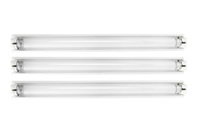
Must green-tipped fluorescent bulbs be managed as universal waste, or can they be managed as municipal waste? Can they be broken to facilitate consolidation for disposal?
Not all lamps are hazardous wastes, and those that are not may be disposed of in municipal waste management facilities. It is the responsibility of the generator of the lamp to determine whether it is a hazardous waste. One way to make the determination is through the Toxicity Characteristic Leaching Procedure (TCLP). The TCLP attempts to replicate the conditions in a municipal landfill to detect the mercury concentration of water that would leach from the landfill. If the mercury concentration exceeds 0.2 milligrams per liter (mg/L), the lamp fails the toxicity test and must be managed as a hazardous waste (or as a universal waste). If the TCLP analysis puts the mercury below the 0.2 mg/L maximum concentration limit, the lamp does not have to be managed as a hazardous waste or a universal waste.
Forget expensive calls to lawyers and consultants. With Enviro.BLR.com, you get instant access, 24/7. Try it out today and get the 2013 EHS Salary Guide, absolutely free. Download Your Free Report.
The amount of mercury in a low-mercury bulb can range from 3.5 milligrams to 4 milligrams compared with a standard fluorescent bulb, which ranges from 8 milligrams to 14 milligrams of mercury. These lamps may be identified by green end caps (often referred to as green-tipped lamps) or green etchings on the lamps.
Some generators have found that an analysis that costs only a few hundred dollars saves their facility several thousand dollars a year in disposal/recycling costs. EPA notes, however, that mercury-containing lamps often fail the TCLP and that the test results can vary considerably, depending on the lamp manufacturer, the age of the lamp, and the laboratory procedures used.
EPA encourages the recycling of all mercury-containing lamps, regardless of the mercury content. According to EPA, if you do not test your low-mercury lamps and prove them nonhazardous, you should assume they are hazardous waste and handle them accordingly (i.e., under the hazardous waste rules or the universal waste rules).
Need an answer fast? Relax. Our editors guarantee a personalized response to your questions within 3 business days. Take a free trial of Enviro.BLR.com and see what everyone is talking about. For a limited time, also receive the new free special report: 2013 EHS Salary Guide. Download Your Free Report
If handling mercury-containing lamps under the federal universal waste requirements, both small and large quantity generators are required to handle universal waste lamps as follows:
- Contain any lamp in containers or packages that are structurally sound, adequate to prevent breakage, and compatible with the contents of the lamps.
- Containers and packages must remain closed and must lack evidence of leakage, spillage, or damage that could cause leakage under reasonably foreseeable conditions.
- Immediately clean up and place in a container any lamp that is broken or any lamp that shows evidence of breakage, leakage, or damage that could cause the release of mercury or other hazardous constituents to the environment. These containers must be closed, structurally sound, compatible with the contents of the lamps, and must lack evidence of leakage, spillage, or damage that could cause leakage or releases of mercury or other hazardous constituents to the environment under reasonably foreseeable conditions.

Totally agree.Most of us would have to De-clutter and clean our houses and garages from time to time, not to mention during the renovation or when moving houses…